
Chapter 4 - My First Liveaboard & Red Sea Voyage
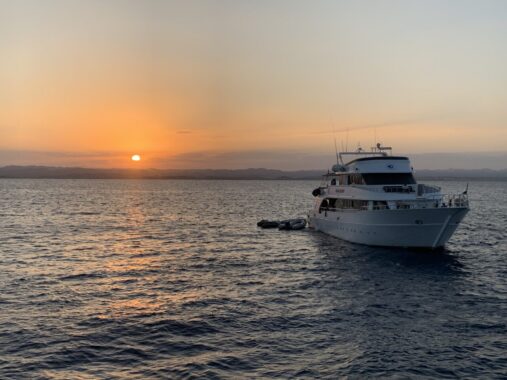
Picture this gentle reader: it is November 2022, as our hero (me) stands gallantly atop the top deck of the Seawolf Dominator; a 42 meter long, state-of-the-art yacht designed for scuba divers.
Slowly at first and then more quickly, the mighty Seawolf Dominator pulls out of Port Ghalib; a small smattering of sandy, sand stained buildings of dustiness and palm trees caked with yet more sand, clustered together along the eastern coast of Southern Egypt.
As Seawolf Dominator dribbles out of Ghalib’s mouth and is unceremoniously spat out into the open sea, the tiny port gradually vanishes out of view, swallowed up by the vast rocky desert behind it which lazily slopes upwards into small, unambitious hills of yellow, brown and beige casting jagged outlines against the cloudless blue sky.
Musing upon this sight for but a moment, I nobly turn around, pausing to thoughtfully scratch my arse as I watch the crystalline blue waters of the Red Sea streaming past below.
I draw a deep breath inhaling the salty air into my lungs. “Alex my lad – here it begins”! I declare to myself loudly, drawing confused looks from several other nearby guests. Excitement courses through my veins. I am about to embark on my first ever liveaboard
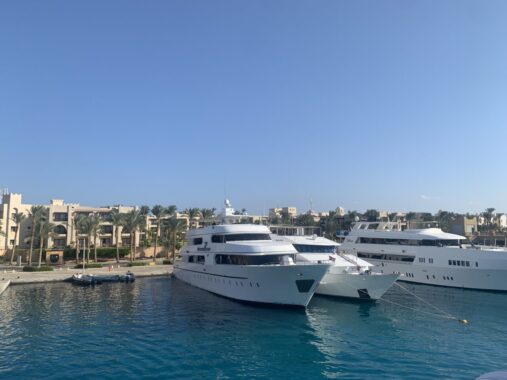
For many moons I had been eagerly anticipating this voyage. Right back to the earliest days of creating Diving Squad in late 2018; I’d been informed that the Red Sea is a spectacular place to scuba dive and should be included in my content. Thus it was that even before diving there I had written about the Red Sea for my blog.
Yet every time I revisited those dust-gathering posts on Diving Squad they stared back at me accusingly, demanding how I could dare to write of such a place that I had not actually been to myself.
And so it was that as my 9 month retreat from society in Kerry, Ireland drew to a close (much needed after a year long bender of diving, driving and partying in Costa Rica), I finally set my sights upon the Red Sea.
Almost all liveaboards that explore the Red Sea do so from Egypt. Egypt’s Red Sea can be divided into two regions: the North Region which is famous for shipwrecks and beginner friendly dive sites and the more off-the-beaten-track South Region; said to have the very best coral reef in all of the Red Sea and to be home and all manner of big pelagic animals like sharks, rays and dolphins amidst strong currents and deep waters.
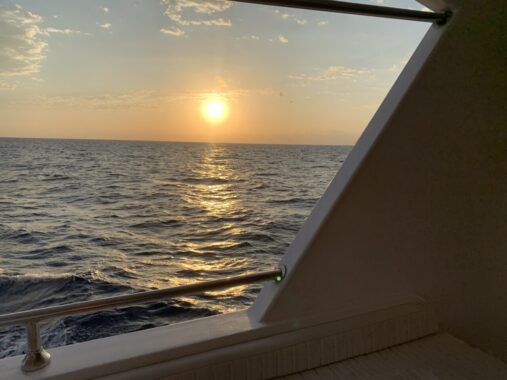
For this trip, I had set my sights upon the South Region with the Seawolf Dominator – we would be diving between Abu Dabab all the way down to St. John’s Reef. More than anything on this trip, I wanted to come face to face with an Oceanic Whitetip Shark (aka Longimanus); the most confident, bold and apparently dangerous shark in the ocean… (awesome!).
On the first day of diving we explored Abu Dabbab; a lonely reef located 50 miles offshore with many spectacular coral-coated pinnacles rising up out of the sand like living rainbow towers and shallow coral gardens.
Countless reef fish of every size, shape and colour, like living confetti, twisted and turned in the warm waters around me, which were crystal clear with visibility that must have been 120 feet so that one could see well into the distance; the incredible underwater terrain of rolling endless, coral-coated pinnacles and soft coral gardens.
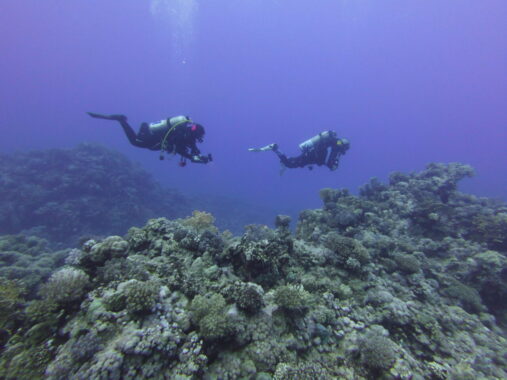
Although we did not see the two resident Dugong said to inhabit this reef; there were turtles, blue spotted rays, octopus and all manner of other underwater beings. “Bygad! This is the best coral I’ve ever seen”! I exclaimed through my regulator. Which underwater must’ve a little something like “Bagab! Mmf mf mmmmff mmfst buh-buh veeem”!
Once more the other guests eyed me suspiciously and swam a little further away as I waved my limbs in excitement, punching the water with glee and accidentally landing a left-hook on a passing turtle which went spinning away and crashed into a rock before exploding.
But it truly was the best coral reef I had ever seen – at least up until that point. In reality, although Abu Dabbab was a stunning place to first discover the Red Sea, it was merely a test dive area for us to make sure our scuba gear was working and we felt comfortable in the water, on account of its shallow waters and non-existent currents.
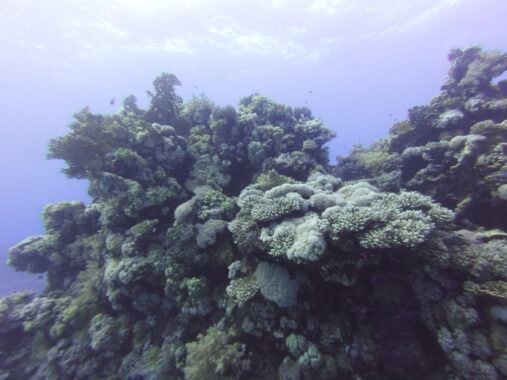
Upon climbing up onto the huge dive deck at the back of Seawolf Dominator, I was delighted to find that for each one of us guests there was a member of staff to help us out of our gear – and hand us a refreshing drink. This was service unlike any I had experienced before.
Then, after the final dive of the day, we were invited up to the outdoor lounge where music was played, icy mocktails were drunk and the golden sun dipped down beneath the horizon magnificently. Next it was time for dinner…
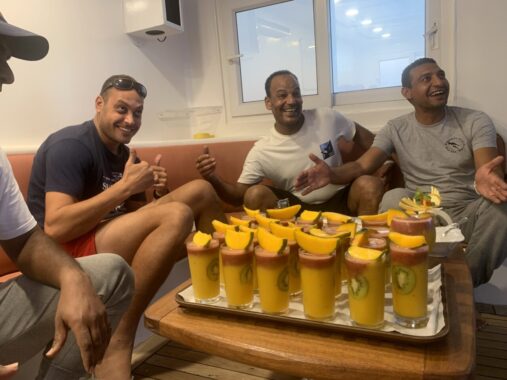
As I sat in the dining area of the indoor saloon, stuffing my face, gracelessly, with delicious calamari, rice and fish, I listened to the guests talking. They were all a stellar bunch; half being German and the other French, which meant that despite listening, I actually had no idea what was being said for most of that week.
Occasionally some kind soul would translate for me (this occurred about 10% of the time). On that evening, the most useful snippet of info translated was that, despite how remarkable the coral reefs of Abu Dabbab were, they would pale in comparison to what lay ahead…
After that; myself and most guests made our way back up to the outdoor lounge where we were greeted by an intriguing sight. At the surface of the still waters surrounding the Seawolf Dominator were three ghostly silhouettes; powerful and streamlined; broad and muscular. “Longimanus”! Someone exclaimed in a hushed whisper of awe. Oceanic Whitetip Sharks.
“Well guys, that means no night dive this evening” Mostafa, one of the two Egyption dive guides said with a wry smile. It was sound advice.
Oceanic Whitetip Sharks are most likely to attack at the water’s surface, at night. It’s believed that they have been responsible for more human fatalities than any other shark species; but that most of these go unrecorded: namely survivors of crashed planes at open sea. During World War 2, the RMS Nova Scotai, a steamship carrying 1000 people near South Africa was sunk by a German sub. Only 192 survived, with many deaths attributed to the Oceanic Whitetip.
So no night dive that night was dived and several shots of German whisky later, I sleepily made my way to my cabin; stopping at the door and turning towards the side rail of the boat to be greeted by two full moons; one in the sky, the other, it’s reflection cast upon the silvery grey outline of the ocean, streaming past as the Seawolf Dominator now plowed through the night towards tomorrow’s destination.
I flung the door open to my cabin; with its beautiful hardwood interior it made me feel like I was aboard some old sailing vessel; flung myself down onto the soft red bed and was engulfed by an ocean of dreamless sleep.
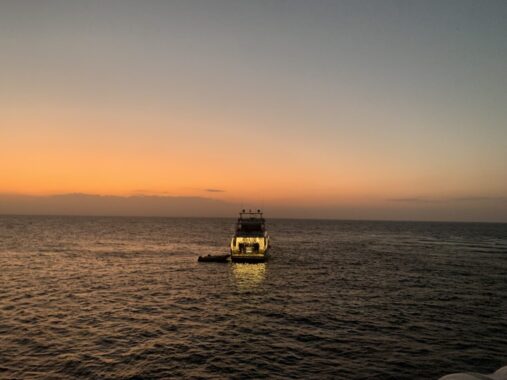
The next day I was awakened by a knock on the door at 6am, the wakeup call signaling that we had thirty minutes to grab a coffee and snack before the first dive briefing.
I leapt out of bed and went bounding down the stairs to chug several coffees and then sprawl across the salon sofa, taking up as much space as possible beneath the large plasma TV upon which there would soon be a 3D map of the first dive site. Today we were to explore Dangerous Reef, named so because of its strong currents and deep waters.
However, as would be the case for much of that week, we encountered practically zero currents at Dangerous Reef and it was an incredibly easy and straightforward dive. I actually learned that whilst the South Red Sea has a reputation as more challenging; this is only because its various dive sites can experience strong currents, but often they don’t.
As had been promised the night before, the reefs of Dangerous Reef were even better than those at Abu Dabbab. This time it was not shallow gardens and pinnacles, but instead great sweeping expanses and plateaus that toppled into mighty walls and then abruptly dropped hundreds of meters down into the seemingly bottomless abyss.
It was the most magnificent and epic marine landscape I had ever witnessed.
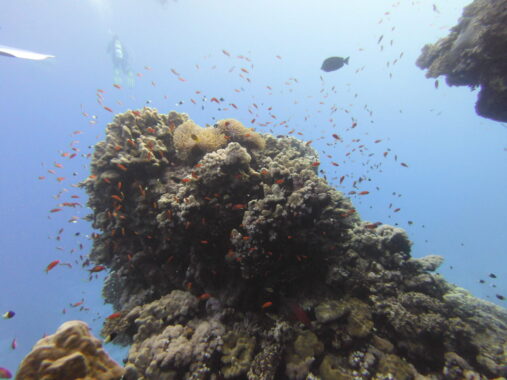
The health and condition of the coral totally blew my mind – to see so much for as far as the eye could see and all of it were in superb condition.
I saw no signs of bleaching, no signs of breakage; something that has never been the case for anywhere else I’ve dived. One of the reasons for this, is that several coral species endemic to the Red Sea are especially resistant to climate change which boosts the overall reef health.
I felt as if I had stepped back in time and been rewarded with a rare snapshot of how the world’s reefs must once have looked before humans came to mould and sicken the earth.
It was another wonderful day of three dives and in between marvelling at the healthy coral and it’s many species of reef fish – whilst also spotting several groups of big pelagic fish like tuna and giant trevally dart past us on the other side through the open ocean, I took many underwater photos of new items of scuba gear that I was reviewing for Diving Squad.
The cursed google algorithm had changed once more and now all the rage was to include original photos of products reviewed. So I had sent off for some of the most popular dive masks of all time; to personally try them myself and take pictures of them.
Back then, most other photos of scuba gear were bland and dull; poorly lit photos of masks by the beach or swimming pool and I wanted to try something different by actually photographing them underwater. I liked taking first-person-view shots from masks, holding my camera behind a mask lens and snapping a shot to try and show the reader the field of vision it provides:
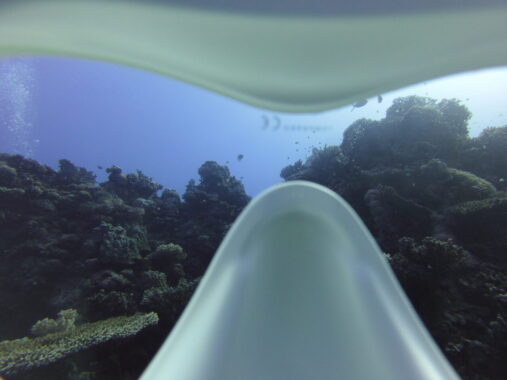
After the third dive of the day; it was time for more sunset mocktails, another hearty dinner with table gossip I did not understand; a surprise dessert (magically appearing next to us with a smile and a cheeky wink from the staff member holding it) and now, with no Longimanus in sight we were able to go on a night dive.
For the night dives, we were allowed to simply pair up and explore on our own without a guide, which was a great way of practicing more independence underwater.
I didn’t see anything particularly spectacular on any of the night dives; they were always in shallow waters around patches of coral garden but it was still interesting to see the different array of tiny fish and crustaceans that come out after dark and how they differ to those seen in the day.
Afterwards, I staggered back to my cabin; downloaded the many photos and videos of my cameras onto my computer to make more space and collapsed back into bed.
The third day of diving was even better than the previous two. Truly our itinerary was structured in a very intelligent manner. We had made it to St. John’s Reef; the southernmost point of Egypt’s South Red Sea. St. Johns is a series of shallow (like five meters!) caverns and tunnels that come together in the middle of the ocean to create an underwater labyrinth.
There’s a great many twists, turns, swim throughs and corners but it’s all incredibly easy to do. This was the closest I had ever come to going through an underwater maze, rollercoaster or other form of aquatic ride albeit at a calm, slow motion sort of pace.
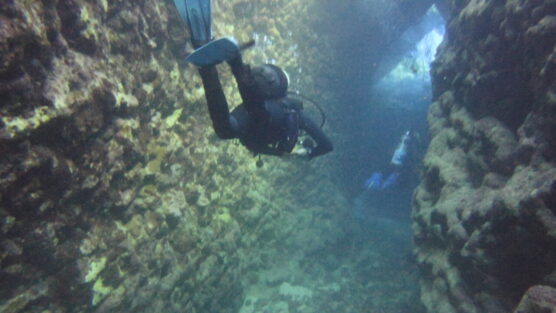
Sadly, this was the only area diving in the Red Sea where the coral was in bad condition; even more sadly it was because of idiot divers (talentless swine!) who’d been too moronic to avoid bumping the coral on their way through the tight spaces, eroding down the coral over many years.
Yet despite this, there was still all manner of fish: anthias, clownfish, parrotfish, triggerfish, cornetfish, butterflyfish, angelfish and morays to name a few so that there it was still very much an alive place. It was both exhilarating and mesmerizing to explore this shallow underwater network of caves and tunnels.
In places, the light slid down through narrow cracks in the rocks above or bounced off the sides of caverns to create patterns of shimmering otherworldliness that made me question what was in my air tank.
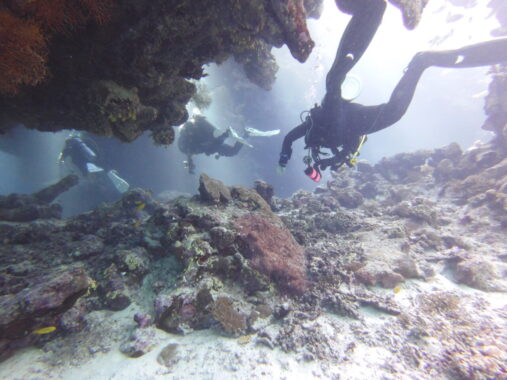
On day the fourth we gradually made our way back northwards; we dived around south Maksour and Sataya which together comprise part of Fury Shoals: a collection of 20 bank reefs and many beautiful dive sites.
As with all the areas we’d dived, it would take far more than just a day to fully discover this place but indeed a day was all that we had and so with it we explored many more beautiful reefs; comprised of pinnacles, walls and swim throughs as well as open caverns. It was like a collection of all the places we’d dived so far on the previous three days merged into one.
I had an amazing encounter with a confident Hawksbill Turtle that practically bulldozed past me on its way to land on and begin ravenously devouring an unfortunate clump of broccoli coral.
Blue spotted stingrays, giant clams, and moray eels were everywhere and as usual, there were all manner of reef fish; seemingly in every shape, colour and size you can imagine as well as two huge green turtles munching away on some seagrass.
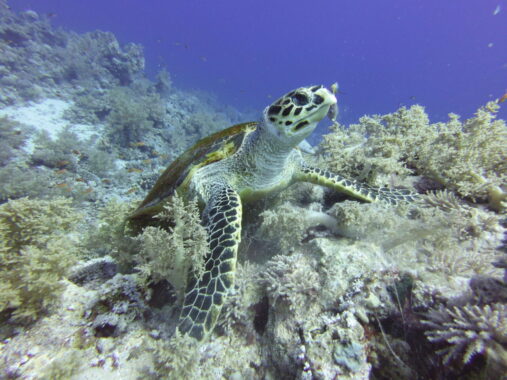
Incredible though the diving was, by the end of day four I was starting to get pretty tired. It usually took some two hours to get the hundreds of videos and photos off my cameras onto my computer each night, in order to ensure I had enough space on the cameras to use them the next day.
Even if I was in my cabin by 10, I usually didn’t get into bed until 12 or even 1 in the morning before having to wake up at 6. And four dives a day will take its toll on the body’s energy, when done over multiple days back to back, as any diver will tell you.
Nevertheless, as I momentarily sailed through the air before landing in my bed that night; I had a moment to roll onto my back and think of all the things I had seen over those previous few days.
The incredible coral reefs and its myriad of underwater beings; the varied, fascinating and friendly boat crew and other guests; the otherworldly land of sandy rocks and mosques we had left at the start of this trip. I wondered how it would all look in another twenty years.
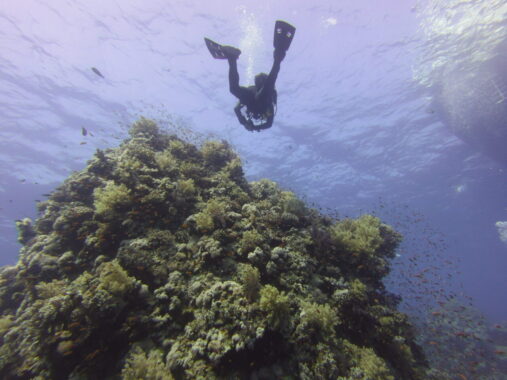
There is no doubt in my mind that the best day was the next one. On day five, our last full day, we had made it to Elphinstone – an area named after the spectacularly incompetent General Elphinstone; an idiot largely responsible for the sheer scale of catastrophe that enshrouded the 1842 Retreat from Kabul i(n Afghanistan), the single greatest disaster in British military history of that century. Nonetheless, even if Elphinstone truly sucked, this dive site, named after him, did not.
For the first time on the voyage, the waters were rough and choppy; that morning they crashed against the sides of the Seawolf Dominator so that for once we could not enter the water with a giant stride from the dive deck and instead had to gingerly climb aboard the two rubber dhonis that precariously rocked back and forth.
After we’d been taken out to more open waters and we backrolled off, the diver to my left went half a second too late and tilted to the side resulting in her crashing towards me; luckily I sensed it would happen and shielded my beloved face from her air tank with my hand resulting in nothing more than a slightly strained wrist.
But it mattered not. This was the place. It was here that we had the best chance of seeing Oceanic Whitetip Sharks. We’d already spent that morning’s briefing watching a video telling us how to dive with these creatures. It explained perfectly why so many folk have succumbed to them.
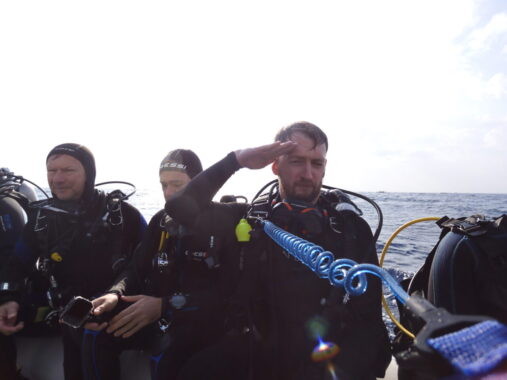
It’s like this: Oceanic Whitetips have a mentality that is unlike practically all other species of shark. Bold and inquisitive, they’re actually nicknamed “sea dogs” around some parts of the world on account of how curious and excitable they are about people. If an Oceanic Whitetip Shark encounters a person; it is practically guaranteed to swim up to an inspect said person.
When this happens; assume a vertical position and maintain eye contact to ensure the Oceanic Whitetip you are a big, confident and powerful predator. Do not make panicked movements, do not swim away and do not turn your back on it. Doing any of these things invariably excites an Oceanic Whitetip and it will then swim in closer to inspect you further.
Even if this happens, all you have to do is stay calm; face it; not move about anymore. It’s kind of like a series of escalating stages in which you have many, many chances to turn the situation around. But the more one panics, the more excited the Oceanic Whitetip becomes until the flurry of hasty, erratic movements finally convinces it that you are indeed food or why else would you be so scared around it.
Only then will it attack – of course because Oceanic Whitetip Sharks hunt prey at the surface, entering and exiting the water is actually the most risky part of an encounter with them…all of this had been explained to us quite clearly in video; we’d signed a form to say we understood it – and now we were ready to dive. Only one diver had chosen to sit things out.
So there we were at the first dive site – North Elphinstone; swimming up and down on the lookout for Oceanic Whitetip Sharks. Not one did we see and I returned to breakfast feeling a little deflated.
Afterwards, we had one more dive around the same area – South Elphinstone this time and because the water had calmed down we were able to enter from the dive deck. Knowing this was most likely the last dive where we had a good chance of seeing this Shark; the one I’d come all the way to Egypt for, I whispered a silent prayer to Poseidon; stuck my regulator in my gob and took a giant stride off the back of the boat.
What happened next surprised me. No sooner had I entered the water and the bubbles around me cleared, me hovering less than two meters from the surface… then I saw the growing silhouette of a rather large Oceanic Whitetip Shark making straight for me.
The mighty apex predator drew within just a few feet and I bore witness to its awesome magnificence. Although just 7ft long; it looked extremely powerful; with a stocky build and strong jaws. The pectoral fins were wide and long; almost paddle-like in their appearance whilst the unusually rounded dorsal fin stretched far back across its body.
At the end of the shark’s sturdy yet streamlined body, its tail split in two; a stumpy lower lobe and a much longer, spiky upper lobe. Mottled white markings sprinkled the tips of these fins and tail lobes; hence the “whitetip” part of the name.
The rest of the creature was a greying bronze colour on top and a white underbelly. The shark slowed as it passed; its copper eyes regarded me intelligently – for a moment it felt like our gaze locked as we both stared at each other in mutual fascination… and then it swam off to inspect another diver!
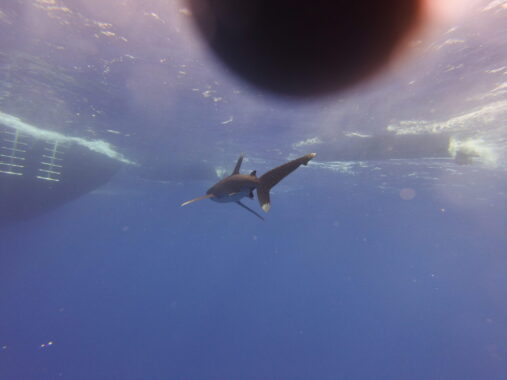
In hindsight I rather wish I’d pretended to be a little more scared because that shark never came back to me again; instead for a good portion of the rest of the dive, it was far more interested in another diver who kept moving back from it jerkily. Even then; it never attacked; eventually growing bored and swimming away.
As with all sharks; Oceanic Whitetips are much more voracious and aggressive in our minds than reality. We saw at least two individuals; the one I witnessed upon first entering the water and another which had a huge bite shaped hole out of its right pectoral fin!
Like the other, this individual very interested in us divers and extremely sure of itself, swimming between the whole group of us, seeming to stare at each individual as it passed by before swimming off and melting back back into the vast open ocean where it spends its life (hence the other part of the name “Oceanic”!).
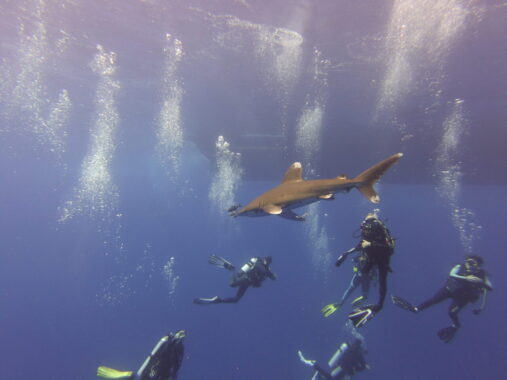
Oceanic Whitetip sharks are incredible animals and getting to see two of them was a humbling and unforgettable experience – it was the main reason I had wanted to dive the South Red Sea and it was definitely the highlight of my trip. It would only have been better if there were more.
Sadly, their numbers are still declining. In fact, it’s estimated by the IUCN that the global population of Oceanic Whitetip Sharks has been reduced by 99.9% during the last three generations (a period of roughly 60 years).
They’re extremely intelligent animals; usually solitary but also known to hunt cooperatively and are intensely curious, vital members of the marine ecosystem by being apex predators. As with so many other declining shark species, the main threat to oceanic whitetips is bycatch in commercial fisheries and the shark fin soup trade.
Let us pray to the Sea Gods that these amazing animals don’t go extinct and that by coming together and cooperating people can find a way to restore their numbers! (But probably we won’t because we’re too busy taking selfies, eating junkfood and complaining about everything).
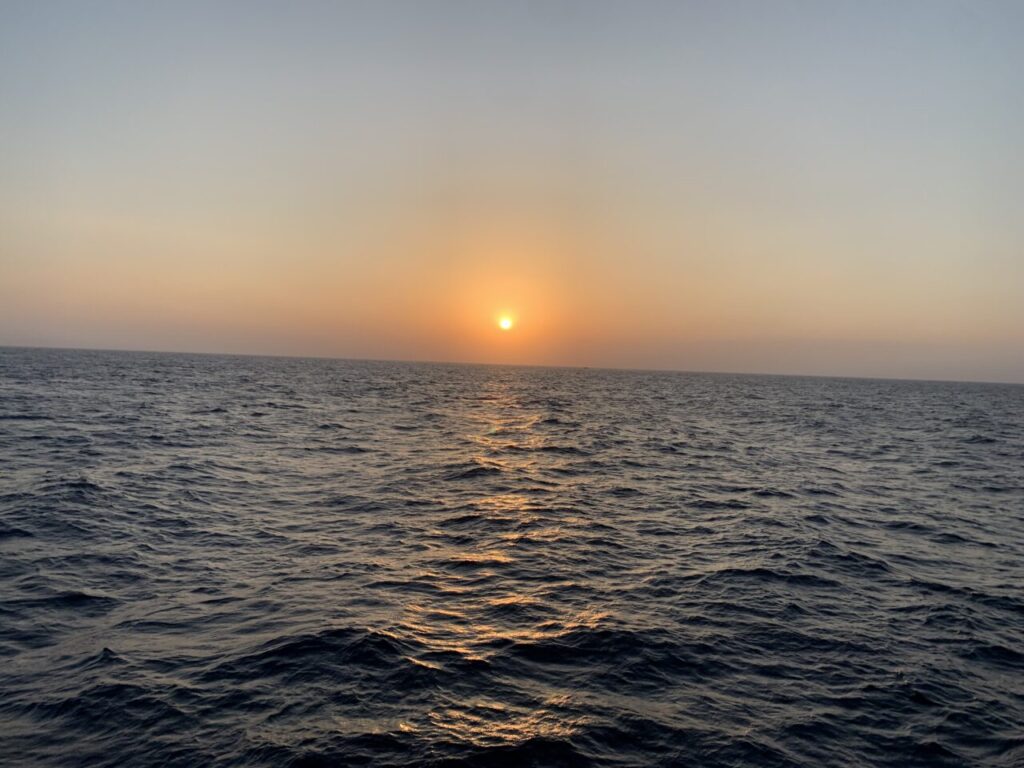
What happened next you might ask; to our our dashing and modest Grand Admiral of the Diving Squad after finishing his Red Sea liveaboard trip.
Upon arriving back at Port Ghalib he promptly made for Luxor; rushing from temple to tomb; darting from rooftop to coffee shop, floating down the river Nile whilst smoking the finest Egyptian Hashish with the boat skipper and finally gazing down upon it all from a hot air balloon in which he was most stoned indeed.
After that he set forth for Dahab; a legendary place upon the Sinai Peninsular in the northernmost tip of the Red Sea. Here he did plan to dive the Blue Hole; allegedly the most dangerous dive site in all the world with some 200 diver fatalities in the last several years.
Every evening he vowed to dive it the next day; yet every day he found himself sucked into a hazy spiral of hashish smoke and Egyptian beer.
It was only on the last day that finally he did make it to the Blue Hole; with barely three hours sleep and an especially nasty hungover; yet dive the Blue Hole of Dahab he did and die he did not. And as it turned out all those fatalities were tec divers anyway! Next it was time for Chapter 5 – the Maldives…